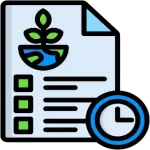Checklist for Moving with Houseplants

At Burnetts Moving Services, a trusted name in intra-US relocations since our founding in 2008, we’ve helped countless families transport their household items safely, including delicate plants. Drawing from our experience, we’ve compiled this comprehensive checklist to guide you through the process. Follow these steps to make your move as smooth as possible for your leafy friends.

Pre-Move Preparation: 2-4 Weeks Before
The weeks leading up to your move are crucial for assessing and prepping your plants. Start early to give them time to adjust.
- Inventory Your Plants: Take stock of all your houseplants. Note their types, sizes, and any special needs (e.g., succulents that prefer dry soil vs. ferns that need moisture). This helps you decide which ones to take and how to pack them. If you have particularly large or rare plants, consider consulting a professional mover like Burnetts Moving Services for custom handling.
- Check for Pests and Diseases: Inspect each plant closely for signs of pests (like aphids or spider mites) or diseases. Treat any issues with appropriate organic pesticides or neem oil at least two weeks before the move. Moving infested plants can spread problems to your new home or violate state regulations on plant transport.
- Research State Regulations: Since you’re moving within the USA, be aware of agricultural laws. Some states, like California or Florida, have strict rules on importing plants to prevent the spread of invasive species. Use the USDA’s website to check for any required certifications or inspections. If needed, obtain a phytosanitary certificate from a local agricultural office.
- Prune and Repot if Necessary: Trim dead leaves or overgrown branches to make plants more compact and easier to transport. If a plant is in a fragile pot, consider repotting into a lightweight plastic container to reduce breakage risk. Avoid repotting right before the move—do this at least a month in advance to minimize shock.
- Acclimate Plants to Travel Conditions: Gradually expose your plants to the conditions they’ll face during the move, such as lower light or varying temperatures. Reduce watering slightly in the week leading up to the move to prevent soggy soil, which can lead to root rot in transit.

Packing Day: 1-2 Days Before the Move
Proper packing is essential to protect your plants from damage during transport.
- Gather Supplies: You’ll need sturdy boxes, packing paper, bubble wrap, plastic bags, and ties. For taller plants, use plant sleeves or cardboard tubes for support. Avoid using newspaper directly on leaves, as ink can transfer and harm them.
- Water Strategically: Water your plants 1-2 days before packing, allowing excess moisture to drain. Overly wet soil can make pots heavy and increase the risk of mold. For succulents and cacti, withhold water for a week prior.
- Secure Pots and Soil: Wrap pots in plastic bags to contain soil spills, then secure with tape. For fragile pots, cushion with bubble wrap. Place plants in boxes with ample padding—use crumpled paper to fill gaps and prevent shifting.
- Label Boxes Clearly: Mark boxes as “Fragile: Live Plants” and indicate which side is up. Include notes on light and temperature preferences if handing off to movers.
- Plan for Transport: If driving, pack plants last so they’re unloaded first. Use your personal vehicle for plants rather than a moving truck, as trucks can get too hot, cold, or dark. For professional moves, discuss plant transport with your service provider—companies like Burnetts Moving Services offer climate-controlled options for sensitive items.

During the Move: On the Road
The journey itself can be the most stressful part for plants, so monitor conditions closely.
- Maintain Ideal Conditions: Keep plants in a temperature range of 50-80°F (10-27°C). Avoid direct sunlight, extreme heat (like a parked car in summer), or freezing cold. If traveling long distances, stop periodically to check on them and mist if needed.
- Provide Airflow and Light: Ensure good ventilation but avoid drafts. If possible, position plants near windows for natural light during stops, but cover them to prevent scorching.
- Handle with Care: Treat plant boxes gently— no stacking heavy items on top. If using a moving service, confirm they’ve secured everything properly to avoid tipping.

Post-Move: Settling In at Your New Home
Once you’ve arrived, prioritize unpacking your plants to help them recover quickly.
- Unpack Immediately: Remove plants from boxes as soon as possible. Inspect for any damage and treat accordingly.
- Rehydrate and Acclimate: Water lightly if the soil is dry, but don’t overdo it. Place plants in a shaded area for a few days to adjust to the new environment’s light and humidity levels before moving them to their permanent spots.
- Monitor for Shock: Watch for signs of transplant shock, like wilting or yellowing leaves. Provide extra humidity with a pebble tray or humidifier if your new home is drier. Fertilize sparingly—wait at least a month.
- Quarantine if Needed: If you suspect pests from the move, isolate affected plants to prevent spreading.

Additional Tips for a Successful Plant Move
- Consider Alternatives for Long-Distance Moves: For cross-country relocations, shipping plants via specialized services or giving cuttings to friends might be safer than risking the journey.
- Eco-Friendly Packing: Use recyclable materials where possible to keep your move green.
- Professional Help: If your plant collection is extensive, enlisting experts can save time and worry. Burnetts Moving Services, with over 15 years of experience in seamless US moves, specializes in handling delicate items like plants to ensure they arrive in top condition.
By following this checklist, you’ll minimize risks and help your houseplants thrive in their new home. Remember, a little planning goes a long way—happy moving! If you’re planning a relocation and need reliable assistance, visit Burnetts Moving Services for a quote tailored to your needs.
